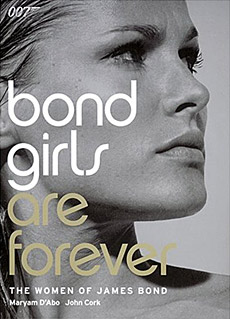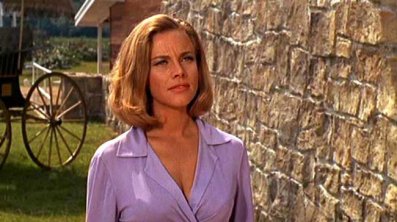|
Bond Girls are Forever

Bond Girls are Forever: The Women of James Bond
was written by John Cork and Maryam D'Abo (who played played Kira
Milovy in the 1987 Timothy Dalton film The Living Daylights) and
published in 2003. The book looks at the ever changing women of James
Bond from Ursula Andress in Dr No up to Halle Berry in Die Another Day
and contains many wonderful photographs, some of them full page size,
over its 192 pages. Although this is by no means the first book to
highlight the women of Bond it is an attractive volume and certainly
makes a change from the rather too familiar illustrated coffee table
Bond books that focus primarily at the films. The book looks at the
lead female characters in the films, changing perceptions of Bond
actresses over the decades, and how Bond girls themselves have had to
adapt to different eras. There is also a section on Ian Fleming and how
he set down a blueprint for Bond women, albeit one that had to be
updated on a regular basis when the film series became an enduring
success story. Bond fans probably won't pick up anything that new here
but the quotes from the various actresses are often interesting and
there are many stills, although a majority of these are disappointingly
familiar.
The book's musings on the origins and influences of women in Bond films
are generally interesting and well put together. Fleming's novels were
considered quite risque for the fifties with their mixture of sex and
sadism and the author himself seemed to have quite a fixation on gamine
and troubled women at times. When Dr No came out in 1962, Ursula
Andress became an immediate icon for walking out of the sea wearing a
bikini and a knife, women in bikinis not a common thing in films around
this time. The book suggests that actresses like Marilyn Monroe might
actually have helped pave the way for Bond girls to some degree or
other, helping the transition from the stuffy fifties to the sixties, a
decade when films became cheekier and the Bond series in particular
took full advantage, practically helping to usher in a new genre of
cinema - the modern action adventure film.
The changing times are conveyed quite well in the book with the
seventies seeming to be the point where the Bond series got the most
criticism for its treatment of women, the argument being they were
purely decorative and regressive as Roger Moore saved the world in a
blazer and a pair of cream flares. While Ian Fleming had more than his
fair of patronising and dated lines that you couldn't get away with
today and the Bond series as a whole is not famed for its strict
adherence to the laws of political correctness, the book does point out
that Bond women have frequently been professional and independent types
doing jobs that people would mostly associate with men in Fleming's
days. Bond women have been spies, astronauts, pilots, assassins, and
even the head of the British Secret Service. 'Before Bond, the parts I
used to play in films were demure, sweet, antiseptic and antisex,'
Goldfinger star Honor Blackman is quoted. 'I wasn't even allowed to
think like a woman. Pussy Galore and 007 worked wonders for me.'

Times are very different when the book reaches the eighties and
nineties. Whereas Sean Connery and Roger Moore had often clocked up
their first conquest by the time the pre-credit sequence had ended,
Timothy Dalton had just D'Abo for company in The Living Daylights. In
an era of AIDS, the relationship between them was romantic rather than
suggestive, at least by the standards of a James Bond film. Political
correctness had started to infiltrate the anachronistic world of James
Bond and this continued when Judi Dench became the new M in 1995 and
told Pierce Brosnan's new 007 he was a sexist, misogynist dinosaur and
relic of the Cold War. The book looks at the relationship between
changes in the series and events in the real world as we trawl through
the decades. The casting of Dench, for example, was a nod to the fact
that it had recently been revealed at the time that the real life head
of MI6 was in fact a woman.
If the book has a thesis, it's that the character of Bond is a
constant, just dressed up in different fashions, whereas Bond women are
the ones who have changed and reflected the times. There is some
element of truth in this perhaps, although the series, even in the
nineties, was still capable of having Denise Richards play a nuclear
physicist dressed like Lara Croft in micro shorts. The book only goes
up to 2003, which is just as well as Bond did change radically in 2006.
If I'm not mistaken he turned into Jason Bourne! Ultimately, a book
like this lives or dies on the images and stills and these are
certainly lavish and striking. The only criticism I would have is that
I was familiar with most of them already from other Bond books and
magazines. It might have been nice to have some stills of a more rare
nature. The book seems a little lighter than some other coffee table
illustrated Bond and film books I have too and maybe could have given
you a bit more. The stills though, of everyone from Ursula Andress to
Diana Rigg to Jane Seymour to Maud Adams to Britt Eklund to Barbara
Bach (and so on), are of a high standard and sometimes take up a whole
page.
I don't think this is quite an essential purchase for Bond fans but
it's certainly worth considering if you chance upon it at a bargain
price as many of the quotes are interesting and the stills are very
good. The text is good too, always quite interesting and displaying a
good knowledge of the series. The only two criticisms I would have is
that not many of the images were new to me and - by the standards of
some of other film books I have of this type - it doesn't seem like the
most dense volume ever. Bond Girls are Forever: The Women of James Bond
is still a lot of fun though and not bad at all.
- Jake
c
2010
Alternative 007
|

|


